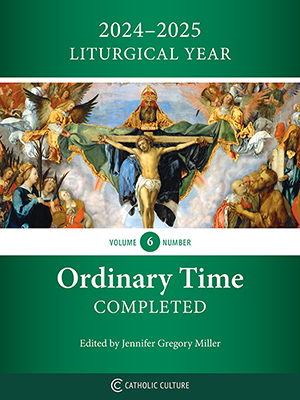Should there be “performances” in Church?
By Dr. Jeff Mirus ( bio - articles - email ) | Jun 06, 2025
According to one of our news stories yesterday, “A German lawyer has filed a formal complaint against Archbishop Udo Markus Bentz of Paderborn, saying that a dance performance in the cathedral—in which performers waved chickens wearing diapers—had desecrated the church.” This is, of course, already a powerful argument for not using Catholic churches for anything that does not have an authentically Christian spiritual purpose. It may be different during periods when a hall is temporarily being used for Mass, of course, but once the Church is built, the purposes of its gatherings should be uniformly sacred.
A Catholic church is not to be regarded as a performance venue, nor even a meeting house, an “environment” for worship, the “living room” of God, or even merely a “sacred space”. Rather, the Church building is supposed to be a visible sign of the living Church—a sign of the Christians whom Saint Paul called “God’s building”, held together by the cornerstone which is Christ himself, the stone the builders rejected. Therefore, the Church building is to be considered a sacrament of the glorified Mystical Body of Christ. It is not one of the seven sacraments; it is not a ritual instituted by Christ to give grace. But it is both the normal locus for these sacraments, and is itself sacramental in the sense of an outward sign—the extraordinary housing and atmosphere, so to speak—within which the grace of Christ is intended to be communicated.
In an essay written in 2021 for Adoremus entitled The Rite Way to Understand a Church Building, Denis R. McNamara outlines the proper understanding of a Catholic church building, as drawn especially from the Catholic Church’s official Order for the Dedication of a Church and an Altar (ODCA). The following quotation offers a fairly clear summary:
The unambiguous ontological conclusion follows: “Rightly, therefore, from ancient times the name ‘church’ has also been given to the building in which the Christian community is gathered to hear the Word of God, to pray together, to take part in the sacraments, and to celebrate the Eucharist“ (DC, 1). Here the theologia prima available in the Church’s liturgical books leaves no room for ambiguity, decimating the common mantra that the Church is only truly the people, so therefore the church building has no value beyond practical necessity.[7] It also invalidates the commonly used anti-sacramental terms “environment” and “space” for church buildings. According to the Church’s own books, the church building is a tangible, material sign of the Mystical Body of Christ, and the space that it encloses takes its character from its tangibility determined by the decisions of its architect. As an image of the glorified Mystical Body of Christ, it is, like Christ’s own person, “at once the house of God and the house of the People of God” (LFS, 22).
The ODCA makes clear that the church “is a sign, in other words, which points beyond itself while at the same time becoming an important means to obtaining that which is envisioned by it.” Or, again, the Church is not simply a reminder of Christ’s Mystical Body but a means of incorporating the faithful into that body: “God’s earthly people are meant to grow into membership in this body through the sacraments of the Church, and the church building foreshadows the glorified unity of heaven and earth which awaits them at the end of time.”
McNamara also emphasizes the point made in the Preface to the Eucharistic Prayer in the liturgy of the dedication of the church itself: “You allow us to consecrate to you apt places for the divine mysteries”. The prayer stresses that a consecrated church is made especially fitting for the celebration of God’s saving work. The church is dedicated to God’s majesty. Within it the mystery of the true Temple is foreshadowed and the image of the heavenly Jerusalem is prefigured. Or, as McNamara expresses it: “The Church is Christ’s body, and the church building is an image of that body brought to glory.”
Abuses
Such considerations enable us to understand not only what the Church building is (and therefore what its design, architecture and art should reflect), but what a Catholic church may properly be used for. And what it should not be be used for is anything like a “chicken dance”, which is to say anything frivolous, or indeed anything at all that is not closely associated with the Catholic ecclesial process of incorporating us more fully into Christ Himself.
This means it is better, on any Catholic “campus”, that the Church itself is not used for plays, concerts, speeches, rallies, celebrations or any other events that do not have a specifically sacred character. Obviously in cases of great need, such as genuine emergencies, exceptions can be appropriately made. Nor is it inappropriate to use it for an extended ceremonial gathering of a Catholic group which is centered around the Mass—for example, a Catholic school’s graduation ceremony. But the Church is not a venue for hosting secular meetings or celebrations, conducting business, or providing mere entertainment (that is, entertainment without a deliberately Catholic spiritual emphasis).
A Church building might be seen far too easily as a solution to all kinds of logistical problems when it comes to accommodating activities throughout the parish. But it is extraordinarily important that the Church itself should not be thought of as a place of general utility, a space that is somehow “wasted” if it is often empty. A properly designed and built Church—intended to be a Church in the proper sense of the term—is never a wasted space as long as it is a sign of the Presence of Christ, and of the very deepest possible connection between God and His people here on earth. Rather, it is wasted only when it accommodates activities which undermine our awareness of the redeeming purposes of Christ.
All comments are moderated. To lighten our editing burden, only current donors are allowed to Sound Off. If you are a current donor, log in to see the comment form; otherwise please support our work, and Sound Off!








